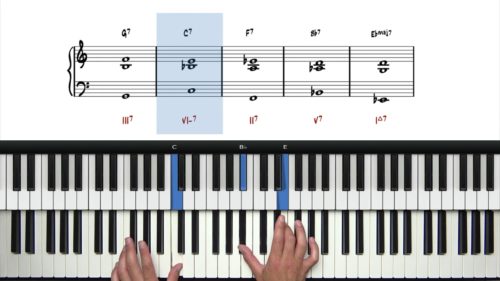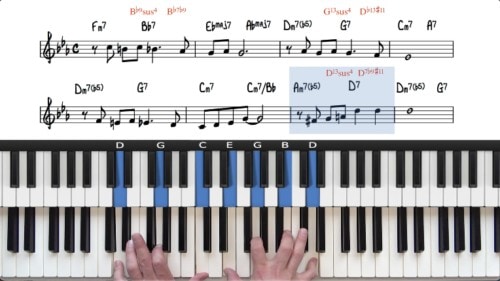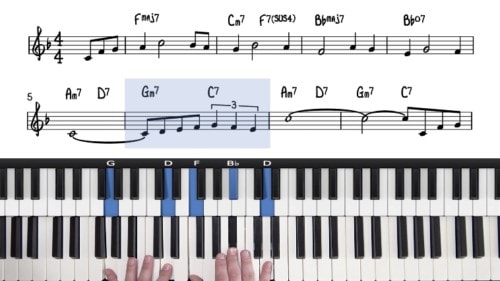"Fly Me To The Moon" Spread Voicings
In the previous lesson we covered the first 16 bars of the tune "Fly Me to the Moon" which consists of the A and B Sections. We will now play through the 2nd half of the tune and create wider spread voicings that incorporate lower bass notes.
Creating Spread Voicings
For this lesson we voice the chords with our left hand one octave lower on the piano. We also play the root and 5th in our left hand to create a stronger foundation. Usually the right hand configuration can stay in the same place and we simply move our left hand 1 octave lower.
"Fly Me To The Moon" Chord Extensions
We touch briefly upon some extended chord voicings, such as including the 13th in our dominant chords. The 13th is the same note of the 6th note of the scale, but when the 7th is present, we refer to the 6th as the 13th.
We cover this theory and application in detail in our course on extended chord voicings and so don’t worry if it’s challenging to visualise the extended tones right now.
Practice Tips
-
Experiment with Registers: Don't shy away from playing chords in different registers of the piano to discover new voicing possibilities.
-
Embrace Finger Flexibility: Practice different fingerings for chords to improve spontaneity when playing and your ability to quickly visualise 3rds and 7ths. There is no 'one-size fits all' with jazz piano fingerings.
-
Left-Hand Bass Notes: Playing the root and 5th in our left hand can be used to add depth to our chord voicings and overall performance.
- Revisit and Repeat: Regularly revisit each sections of the tune - particularly the ones that you find challenging. Remember to clearly visualise the 4 sections of the tune (A-B-A-C).







Hello Hayden,
Looking for structured courses to learn piano blues/jazz, I’ve opted for Pianogroove after a quick review on the net. The first two weeks spent on the Reading Lead Sheets For Beginners course (about 60% progression) seem to answer to my expectation. I notice that in the two first jazz standards tutorials we learn to built spread voicings with the both hands and to built different voicings for a same chord, so it’s mainly a “theoric” or “harmonic” approach. I know it will take time to assimilate this knowledge and to feel the effect in the playing.
But what about the rhythm of the the left hand ? Is it studied further in the course, or a next beginner course, or is it something to study whith a higher level, once harmony, chord building (and playing) are established ? Now I play mainly the chord whole note or dotted minim (Blue Moon) or rocking like you show in the tutos.
FYI I play mainly on my own for two years now, and took some lessons. My teacher made me work on Blue Monk, Blue Bossa, Perdido asking me to improvise as soon as I know the basic of the leadsheet, but I felt it frustrating cause I was lost without tools to understand (what he didn’t give), so this approach of chord building seems really adapted to my need.
Hi Guillaume,
Thanks for your message and I’m really glad to hear you’re enjoying the Reading Lead Sheets For Beginners course so far!
You’re right that the early jazz standard tutorials take a more harmonic approach. We’re exploring voicings and chord progressions mainly through jazz ballads, which are perfect for learning how to interpret lead sheets slowly and thoughtfully. This gives you a strong foundation before layering in rhythmic comping techniques.
Rhythmic development does come in later courses — once basic progressions and harmony are internalized. Right now, you’re playing whole notes, dotted minims, or a rocking pattern — that’s exactly where we’d expect a student to be at the 60% mark of the Reading Lead Sheets course so you’re doing great.
Keep going, and feel free to reach out with any other questions as you move forward.
Best,
Hayden
Thanks a lot for your answer !